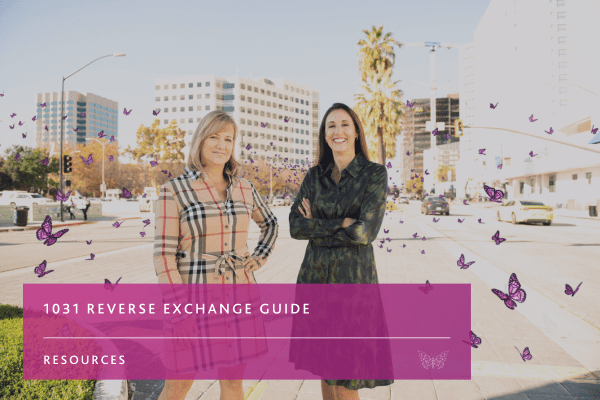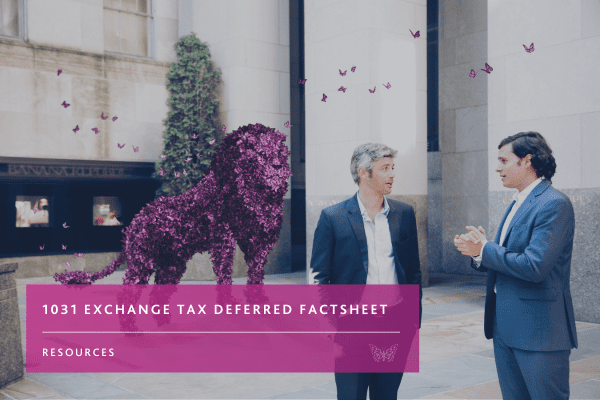To download this guide as a PDF, fill out the form at the bottom.
How a reverse exchange works, why you might want to consider one, and the services you’ll need to properly execute a more flexible 1031 exchange.
For more than 100 years, taxpayers have utilized Section 1031 like-kind exchanges to defer taxes and build wealth. By exchanging a property held for business or investment purposes for another property of like kind, you can defer payment of certain taxes and use your acquired capital as part of a smart diversification, retirement, or estate-planning strategy.
Most exchangers are familiar with the traditional forward exchange, in which one property is sold and another later acquired to replace it. Less common is the reverse 1031 exchange, where the process is altered to accommodate scenarios when the forward exchange procedure isn’t as advantageous.
In order to successfully complete a reverse exchange, you’ll need to understand the requirements, as they differ from those of a forward exchange. As experts in reverse exchanges, we at JTC want to give potential exchangers the tools to properly pursue and execute the type of exchange that makes sense for them.
In this guide, you’ll learn the reasons why people pursue reverse exchanges, the different types of reverse exchanges, the rules that govern them, and the services you’ll need in order to successfully defer taxes. And when you’re ready to embark on an exchange, no matter the type, JTC is ready to hear from you .
Table of Contents
- Section-1031-Like-Kind-Exchange -The-Basics
- What-is-a-Reverse-Exchange?
- Why-a-Reverse-Exchange?
- Drawbacks-of-a-reverse-exchange
- Types-of-Reverse-Exchange
- “Safe Harbor”-and-Rules-for-Reverse-Exchanges
- The-Reverse-Exchange-Process
- What-You-Need-for-a-Reverse-Exchange
- When-Should-I-Decide-What-Kind-of-Exchange-to-Perform?
- The-JTC-Advantage
- Want-more-information?
1. Section 1031 Like-Kind Exchange – The Basics
When you sell business or investment property, you may have to pay capital gains taxes, depreciation recapture, net investment income tax, and state taxes, depending on where you live. However, Section 1031 of the Internal Revenue Code allows for taxes to be deferred through a qualifying exchange of like-kind property. By purchasing a property to replace one that has been sold, the taxpayer can defer certain taxes on the sale. By deferring taxes to a later date, the taxpayer can use the invested capital to build more wealth and potentially take advantage of a more optimal tax environment in the future.
For more information, be sure to read our 1031 Exchange Guide, which goes into greater detail about 1031 rules, the benefits of an exchange, and what to look for in a Qualified Intermediary.
Section 1031 only applies to real property, but the definition of “like-kind” is quite generous. Generally, any property held for business or investment purposes will be eligible for inclusion in a 1031 exchange. Single-family residences, multifamily apartment buildings, commercial office or retail space, farmland, warehouses, or even an interest in a Delaware Statutory Trust (DST) can be exchanged for one another.
Unsure of whether your property can qualify under 1031? Read this article on the differences between Section 1031 and Section 121 and when a primary residence or vacation home can qualify for a 1031 exchange.
The most common type of 1031 exchange is a forward exchange. In this scenario, “relinquished property” owned by the exchanger is sold to an outside party. The sale proceeds are held by a Qualified Intermediary (QI) so that the exchanger does not possess constructive receipt or control of them upon closing. The exchanger has 45 days to identify and 180 days to purchase like-kind “replacement property.” The QI then releases the exchange funds to pay for the acquisition of the replacement property, completing the exchange.
To learn more about the forward exchange process, read our How to Perform a 1031 Exchange factsheet.
If the replacement property is not acquired within 180 days or the procedure is not properly followed in accordance with all 1031 rules, the exchange will be unsuccessful. If that happens, the sales proceeds will be returned to the exchanger and will be subject to taxation. However, there are some situations where you may have fewer than 180 days, which is one reason the right tax and legal advice is so valuable when pursuing an exchange.
Concerned about the tax ramifications of a failed exchange? Read this article about how tax straddling can be a hedge against a failed 1031 exchange.
While a forward exchange is the most common scenario, it is not the only method for performing a 1031 exchange. There can be tremendous value to another method, known as a reverse exchange.
2. What is a Reverse Exchange?
A reverse exchange provides the same tax deferral benefits as a forward exchange, but offers greater flexibility regarding when each stage of the process occurs. In a reverse exchange, it’s possible to acquire the replacement property before completing the sale of the relinquished property, provided all IRS guidelines are followed.
In a forward exchange, you have an exchanger, a buyer, and a seller. The buyer purchases the relinquished property from the exchanger. The sales proceeds are held by the QI until they are used to purchase the replacement property from the seller, at which time the title to the replacement property and any leftover exchange funds are returned to the exchanger.
Trying to decide if a 1031 exchange is right for you? Read this article on choosing between a 1031 exchange and a taxable sale.
A reverse exchange can be used in scenarios where you wish to purchase your replacement property but don’t yet have access to those sales proceeds. For example, let’s say you know which replacement property you wish to acquire but haven’t yet found a buyer for your relinquished property. To perform a standard forward exchange, you’d have to wait until you found a buyer to proceed with the exchange, and may risk losing out on the replacement property during that time. A reverse exchange lets you acquire the replacement property first so you don’t lose out on your preferred property.
To make a reverse exchange work, a third-party special-purpose entity is required. This entity, called the Exchange Accommodation Titleholder (EAT), acquires title to the property and “parks” it according to IRS “safe harbor” rules. Either the relinquished property or the replacement property can be parked, and the type of reverse exchange depends on which property is being parked.
By having this entity stand in for one of the exchange parties, you can start your exchange without needing to find a buyer or even identify your relinquished properties at the outset. Though the applications for this procedure may not be obvious, there are situations where a reverse exchange can provide unique benefits.
3. Why a Reverse Exchange?
While preserving the tax benefits of a forward exchange, a reverse exchange allows greater flexibility to accommodate the business needs of the exchanger. The most obvious situation where a reverse exchange would be advantageous is when a desirable replacement property becomes available unexpectedly.
By having the EAT acquire the replacement property and park it, you (the taxpayer) won’t be taking constructive receipt of the property. You can then select a relinquished property, find a buyer, and complete your exchange without violating the rules of Section 1031.
While a property is parked, it can be leased, and building improvements can be made on it. This allows the exchanger to get started on making necessary improvements to the replacement property right away, rather than waiting until closing on the sale of the relinquished property.
In competitive real estate markets, it may be easier to find a buyer for your relinquished property than it is to find a suitable replacement property. Because of the time limits placed on 1031 exchanges, it’s a good idea to take care of the more difficult transaction first. That’s why reverse exchanges become more popular when the supply of available properties is lower. If finding a buyer in 180 days seems less daunting than finding a replacement property, a reverse exchange is worth considering.
4. Drawbacks of a reverse exchange
While a reverse exchange can offer strategic advantages not possible with a forward exchange, the reverse exchange structure can also present its own unique challenges.
In a traditional forward exchange, the proceeds from the sale of the relinquished property are used to purchase the replacement property. In a reverse exchange scenario, the relinquished property has yet to be sold at this stage, meaning you won’t have access to those proceeds.
Instead, the exchanger must supply additional capital. Not everyone has access to the level of liquid capital required to purchase a property and park it for a period of time, and those that do may not want to have so much tied up in a single transaction. That’s one reason why forward exchanges are much more popular – they require less liquid capital from the exchanger.
If the exchanger doesn’t have the necessary capital, a loan will be required. In an Exchange Last scenario, this loan will technically be taken out by the EAT for purchase of the replacement property. Some lenders may not be willing to make a short-term loan with this entity for purchase of certain property types. This depends upon many factors, including the exchanger’s relationship with the lender, the replacement property, the relinquished property (if used to secure the loan), and the structure of the exchange, but what’s important to understand is that it isn’t a given that you’ll be able to find a lender for your exchange.
The biggest reason reverse exchanges are less common than forward exchanges is complexity. The forward exchange process is simpler and easier to navigate, while the reverse exchange process can be cumbersome. Many Qualified Intermediaries have little experience with this type of exchange, and may not have enough familiarity with the specific rules that govern these transactions to properly execute complicated scenarios.
To learn more about what to look for in a QI, read this article about how to select the right 1031 Qualified Intermediary for your exchange.
At JTC, we specialize in reverse exchanges and know the types of problems that can arise. It’s important to work with service providers who have experience in these areas, and to get the right legal and tax advice to be sure this type of exchange is the right choice for you.
While a forward exchange generally comes in a single variety, with the main differences being in the number of relinquished or replacement properties, there are different ways to structure a reverse exchange. Potential exchangers need to understand what types of reverse exchange exist and how their processes differ.
5. Types of Reverse Exchange
Type One: Exchange Last
In this scenario, the EAT “borrows” capital (either from the exchanger or from a lender) to purchase the replacement property and parks that property. While the property is parked, the EAT holds title to the property, but the exchanger is able to lease or build improvements on it, and is entitled to receive any generated income from the property.
The exchanger has 45 days from the date the replacement property is parked by the EAT to identify the relinquished property in accordance with 1031 identification rules and has 180 days from the date the replacement property is parked by the EAT to complete the sale of the relinquished property. Proceeds from the sale of the relinquished property will be held by the QI as in a forward exchange.
The “exchange” is then performed with the EAT acting as the seller of the replacement property, with title transferred to the exchanger. After the exchange is complete, ownership of the EAT will be transferred to the exchanger along with all remaining funds from the exchange.
One benefit of the Exchange Last procedure is that the exchanger does not have to choose which property to sell before acquiring the replacement property. This allows exchangers who own multiple properties to properly survey the market and determine which property to sell so that the sales proceeds will match (as closely as possible) the cost of the replacement property.
The drawbacks of an Exchange Last procedure include potential difficulty in securing a loan for purchase of the replacement property by the EAT. An Exchange Last scenario also requires the investor to select the replacement property up front, so if you’re considering more than one property, you won’t have time for further due diligence. While Exchange Last is the most common type of reverse exchange, there is another method useful in certain scenarios.
Type Two: Exchange First
The big difference between Exchange First and Exchange Last is that in an Exchange First reverse exchange, the EAT takes title to the relinquished property, not the replacement property. Capital is borrowed from the exchanger by the EAT, and the relinquished property is “sold” to the EAT at its estimated fair-market value.
The “exchange” occurs when the proceeds from the sale of the relinquished property to the EAT are used to purchase the replacement property. This portion of the exchange is similar to the procedure for a forward exchange, with the EAT standing in for the buyer of the relinquished property.
The relinquished property is parked until it can be sold to an outside party. Once this sale has been completed, ownership of the EAT is transferred to the exchanger along with the proceeds from the sale of the relinquished property. This must all be completed within 180 days of the EAT parking the replacement property.
One advantage of this procedure is that it eliminates concerns about the EAT having to secure a loan for the purchase of the replacement property. For an Exchange First scenario, any loan is secured by the taxpayer, not the EAT, simplifying the process. If you already know which property will be your relinquished property, an Exchange First method could be advantageous.
The downside to this structure is that since the EAT is purchasing the relinquished property from the exchanger, the value of this property must be estimated up front. If the relinquished property is eventually sold to an outside buyer for more than the value of the replacement property, it will result in a “boot,” and could be subject to taxes.
In addition, If there is an existing loan on the relinquished property, the transfer of ownership to the EAT could trigger the due on sale clause in the loan agreement and potentially increase the county property tax basis.
To learn more about the “boot” in a 1031 Exchange and how to avoid one, read JTC’s guide to taxable boot in 1031.
Both scenarios have their advantages and disadvantages, but no matter which method you choose to pursue, you’ll need to follow all IRS rules for reverse exchanges. Whether parking the relinquished or replacement property, the parking arrangement must follow Safe Harbor rules in order to qualify for tax deferral.
6. “Safe Harbor” and Rules for Reverse Exchanges
1031 Exchanges are governed by IRS procedures that create a “safe harbor.” What this means in practice is that if these procedures are followed, exchangers can act without getting a ruling from the IRS first. For example, there are safe harbor rules regarding whether a property can qualify as being “held for productive use in a trade or business or for investment” so exchangers can have confidence their properties will qualify under Section 1031.
There are specific safe harbor rules that govern reverse exchanges. To create a safe harbor parking arrangement, you need to enter into a specific type of agreement (known as a Qualified Exchange Accommodation Agreement, or QEAA) with the EAT. This agreement must be entered into within five days of the EAT taking title of the parked property. In addition, the combined time frame the relinquished and replacement properties are held in a parking arrangement cannot exceed 180 days.
There are many other rules for reverse exchanges that must be followed, and there is always the potential for change through future IRS rulings. That’s why it’s important to work with tax and legal experts and an exchange accommodator experienced in this type of exchange so you can be confident you’ll qualify for tax deferral.
7. The Reverse Exchange Process
Exchange Last
- Formation of EAT
- EAT “borrows” capital from exchanger or lender and uses it to acquire replacement property
- Seller deeds the replacement property to the EAT
- EAT leases the replacement property to the exchanger
- Exchanger must identify relinquished property within 45 days of parking the replacement property
- Relinquished property must be sold to third party-buyer within 180 days of parking the replacement propert
- QI is assigned sale proceeds from the relinquished property
- Exchange is completed with EAT receiving sales proceeds and exchanger receiving title to replacement property (must be completed within 180 days of parking the replacement property)
- Ownership of EAT is turned over to exchanger along with sales proceeds
Exchange First
- Formation of EAT
- EAT “borrows” capital from exchanger and assumes existing loan on relinquished property (if any
- EAT acquires relinquished property from exchanger, with Qualified Intermediary taking control of the exchange funds
- QI uses exchange funds to acquire replacement property
- Taxpayer takes control of title to replacement property and receives any excess boot
- EAT leases the relinquished property to the exchanger
- Relinquished property must be sold by the EAT to a third-party buyer within 180 days of being parked
- EAT uses relinquished property sale proceeds to repay the exchanger for the advance used to acquire the relinquished property at the start of the exchange
8. What You Need for a Reverse Exchange
Even if you understand the procedure for a reverse exchange, it’s not something you can do on your own. There are a number of services you’ll need in order to execute your exchange properly:
Tax and legal advice
The right legal and tax experts can help you determine if your planned exchange is the correct move. Will it qualify for tax deferral under Section 1031? Is now the right time? How will this affect your tax status for the current year? Are there any legal issues regarding the ownership structure of the property? All of these are questions the right advisors can help you with, and no exchange should be executed without experienced help.
Creation of the EAT and parking arrangement
An EAT is a crucial element of any reverse exchange. As explained above, the EAT is a special-purpose entity (such as an LLC) that enters into a parking arrangement with the exchanger in order to acquire title to the property that is to be parked.
The SMLLC typically will be transferred to the exchanger at the conclusion of the parking period to complete the exchange. This is treated as a transfer of the parked property to the exchanger for federal income tax purposes and may avoid local real property transfer taxes. Alternatively, the EAT can deed the parked property to the exchanging taxpayer in the same manner in which they held title to the relinquished property.
Loan services
If a loan is required for the exchange, document negotiation and execution will be required for the lending process. For example, capital may be borrowed by the EAT from the exchanger, or equity may be used to secure a loan from a lender. The terms of these loans must be such that they will not affect the reverse exchange process; for example, any loan with a term shorter than the 1031 Exchange timeline or that requires partial repayment prior to full execution of the exchange will not work. The loan must be completely non-recourse to the EAT with the ability for the exchanger to assume the loan at the completion of the exchange or 180 days from parking the replacement property – whichever occurs first.
Qualified Intermediary
An important element of any 1031 exchange is that the exchanger cannot be in possession of the sales proceeds from the relinquished property and the title to the replacement property simultaneously. The QI will hold exchange funds (preferably in a qualified escrow account) until they are released to the seller of the replacement property. Not all QIs have experience with reverse exchanges, so it is critical to find a QI that understands the specific type of reverse exchange you plan to execute.
To learn more about JTC’s industry-leading 1031 Qualified Intermediary services, download our 1031 Exchange Factsheet.
Property identification and documentation
Potential relinquished properties must be identified in writing within 45 days from the date the EAT acquires title to the parked property. Correct procedure must be followed for notification of the identification of these properties. Documentation is also required for the parking and exchange transactions, both at their commencement and execution.
Full execution of the exchange
With all these elements in place, the exchange must be executed according to IRS rules. That means all funds and property titles must be handled in accordance with 1031 guidelines so as to avoid violation of the safe harbor rules. Without proper execution of the 1031 exchange procedure, the exchange may fail to qualify for tax deferral.
9. When Should I Decide What Kind of Exchange to Perform?
While each type of exchange starts with the sale or acquisition of a property, you shouldn’t just launch into those transactions and expect to be able to set up the exchange later. The procedures are very different for each type of exchange, and setting up the correct entity to act as the EAT must be done prior to the start of the exchange.
The best time to decide is early, before any property is bought or sold. Consult your tax and legal advisors to make sure you understand the costs associated with the type of exchange you’re hoping to attempt, the risks involved, and whether you can achieve your tax deferral goals through the intended exchange.
For more information, read our guide to when you should contact a Qualified Intermediary about your 1031 exchange.
10. The JTC Advantage
By their very nature, reverse exchanges are more complex than forward exchanges. Not all Qualified Intermediaries can accommodate reverse exchanges, but JTC is one of the industry experts in these types of 1031 exchanges.
JTC offers an end-to-end solution for reverse exchanges, with combined EAT and QI services from an experienced team. Our offerings include:
- Creation of special-purpose entity to act as EAT and acquire title to the property to be parked
- QI services to hold funds during the exchange
- Documentation for both exchange and parking transactions
- Loan document execution
- Legal agreements for leasing or construction management
- Qualified Escrow or Qualified Trust to hold proceeds from sale of relinquished property, if necessary
- Assistance with timely notification of parking and exchange deadlines
- Digital archiving of executed exchange documentation
JTC combines its industry-leading technology and 1031 expertise with a “one team” approach to Client Services that ensures you’ll always know who to contact about your exchange and will always have access to up-to-date information. Some of the benefits of working with JTC include:
- 24/7 online access to exchange information
- Dedicated Client Services team
- Comprehensive audit trail
- Exchange funds only held in FDIC-insured, fully liquid accounts
- Errors and omissions and cyber insurance
- Exchange funds placed in individual qualified escrow accounts, never commingled in operating accounts
- Automated document management
- Dual-authorization disbursement of funds
- Experience with less common exchange scenarios like those involving Delaware Statutory Trusts
When performing an uncommon and complex procedure like a Section 1031 reverse exchange, work with trusted experts who can help you achieve your financial goals. The team at JTC works with our clients to ensure they get the help they need, offering complete service throughout the entire exchange process.
For more on JTC’s end-to-end services for Section 1031 reverse exchanges, read our 1031 Reverse Exchange factsheet.
11. Want more information?
Still have questions about reverse exchanges or Section 1031 in general? Interested in learning more about JTC’s services? Have a specific situation you’d like to ask about?
Fill out the form below to receive a complimentary commitment-free consultation where you can speak with one of our 1031 experts who can answer questions and help you better understand the exchange process. We’re ready to help you make the right decisions for your financial future.
Stay Connected
Stay up to date with expert insights, latest updates and exclusive content.
Discover more
Stay informed with JTC’s latest news, reports, thought leadership, and industry insights.
Let’s Bring Your Vision to Life
From 2,300 employee owners to 14,000+ clients, our journey is marked by stability and success.


















